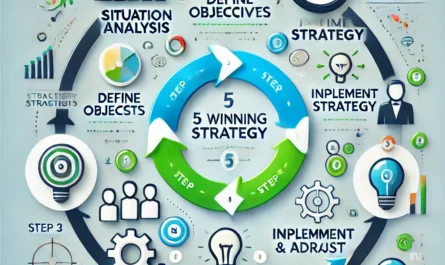The world of business is continuously evolving, and 2024 presents both unique challenges and abundant opportunities. To thrive in this dynamic environment, a well-structured business strategy is paramount. Whether you’re launching a startup, expanding a growing business, or sustaining success, knowing how to craft and execute an effective business strategy will make a significant difference. The strategies you build today will shape your company’s future, helping you achieve sustainable growth while staying ahead of the competition.
Let’s dive into the essential elements of developing a successful business strategy for 2024, exploring the latest trends, tools, and techniques that can fuel your success.
Why Business Strategy Matters in 2024
A solid business strategy has always been the backbone of successful organizations. However, in 2024, the stakes are higher than ever. With global markets becoming increasingly competitive and technological advancements continuing to accelerate, businesses that lack a coherent strategy will struggle to survive.
Companies today face uncertainties, such as fluctuating consumer behaviors, economic instability, and ever-evolving market demands. This makes it critical for business leaders to develop a forward-thinking strategy. By defining a clear path, anticipating market shifts, and planning for contingencies, businesses can minimize risks and capitalize on emerging opportunities.
A well-planned business strategy not only directs daily operations but also aligns your business toward long-term growth. It empowers your organization to stay agile and responsive while keeping an eye on profitability, sustainability, and innovation.
Defining the Core Elements of a Business Strategy
At its core, a business strategy is a roadmap for achieving your company’s vision. It lays out a clear direction by answering key questions such as:
- What are your long-term objectives?
- What competitive advantages do you have?
- How will you meet the needs of your customers?
- What resources will you allocate toward your goals?
These foundational elements provide the structure for setting actionable plans. The clearer your strategy, the easier it becomes to align your team and resources. Additionally, it ensures that your business remains adaptable to market changes while still focused on achieving your core objectives.
How to Use Market Research to Shape Strategy
An essential aspect of developing a successful business strategy for 2024 is understanding your market. Without accurate market insights, even the most well-crafted strategies can fall flat. Market research allows you to gather crucial data about customer preferences, competitor activities, and emerging trends that could influence your industry.
To make informed decisions, companies must conduct both primary and secondary research. Surveys, interviews, and focus groups offer firsthand insights, while reports, statistics, and trend analyses provide a broader industry view. The more informed you are, the better positioned you’ll be to tailor your strategy to current market demands.
By identifying potential growth areas, customer pain points, and gaps in the market, you can adapt your strategy to remain competitive. Regularly updating your market research is critical, as the business landscape in 2024 will likely continue to shift.
Key Business Trends That Will Shape Strategies in 2024
In 2024, several key trends are expected to shape business strategies across industries. Companies that anticipate and align with these trends will have a competitive edge. These include:
- AI and Automation: Businesses are increasingly adopting artificial intelligence and automation to streamline operations and improve decision-making processes. AI-powered solutions can analyze vast datasets, offer predictive insights, and enhance customer interactions.
- Sustainability: With consumers becoming more environmentally conscious, businesses are under pressure to adopt sustainable practices. From reducing carbon footprints to creating eco-friendly products, sustainability will be central to brand reputation and customer loyalty.
- Remote and Hybrid Work: The COVID-19 pandemic permanently altered the workplace landscape. In 2024, remote and hybrid work models will continue to dominate. Businesses must build strategies that embrace flexibility while ensuring productivity and employee engagement.
- Digital Transformation: Companies that lag in digital adoption will struggle to compete. Leveraging technologies such as cloud computing, blockchain, and 5G will be essential for improving operational efficiency and customer experiences.
Understanding these trends and incorporating them into your business strategy is vital for staying relevant and competitive.
SMART Goals for Strategy Development in 2024
Setting goals is a critical part of developing a successful business strategy. However, not all goals are created equal. To ensure your goals lead to actionable results, follow the SMART framework:
- Specific: Clearly define what you aim to achieve. Avoid vague statements like “increase revenue” and opt for more precise goals, such as “increase revenue by 15% in the next 12 months.”
- Measurable: Ensure your goals have measurable outcomes. This allows you to track progress and make necessary adjustments.
- Achievable: Your goals should be realistic given your available resources and market conditions. While it’s great to aim high, overly ambitious goals can demotivate your team.
- Relevant: Make sure your goals align with your long-term vision and current market environment.
- Time-bound: Set deadlines for achieving your goals. Without a timeline, it’s easy to lose focus and motivation.
By applying the SMART criteria, you can ensure that your strategy has clear, actionable steps, with measurable milestones to track progress.
How to Build and Sustain a Competitive Advantage
One of the most important aspects of business strategy is building and maintaining a competitive advantage. A competitive advantage is what sets your business apart from others in the market, giving you an edge in attracting and retaining customers.
To build a competitive advantage, identify your company’s unique strengths, whether it’s superior products, exceptional customer service, or innovative technology. Once established, you need to protect and sustain this advantage by continuously improving and innovating.
Businesses should also focus on differentiation. Offer something that your competitors do not, or do it better. Whether through product uniqueness, exceptional branding, or personalized customer experiences, differentiation will help you stand out in a crowded market.
You can also read; How to Integrate AI into Existing Software Solutions
Why Customer-Centricity is Key to Strategy
In 2024, businesses that put the customer at the heart of their strategy will be the most successful. Customer-centricity means deeply understanding the needs, preferences, and behaviors of your target audience and then aligning your products and services to meet those needs.
To adopt a customer-centric approach, focus on delivering value throughout the customer journey, from the initial touchpoint to post-purchase support. Tailoring your offerings to solve real problems for your customers builds loyalty and trust, which are invaluable in today’s competitive marketplace.
Investing in customer experience, personalization, and strong communication will ensure that your strategy is aligned with customer expectations, helping you grow your brand in meaningful ways.



